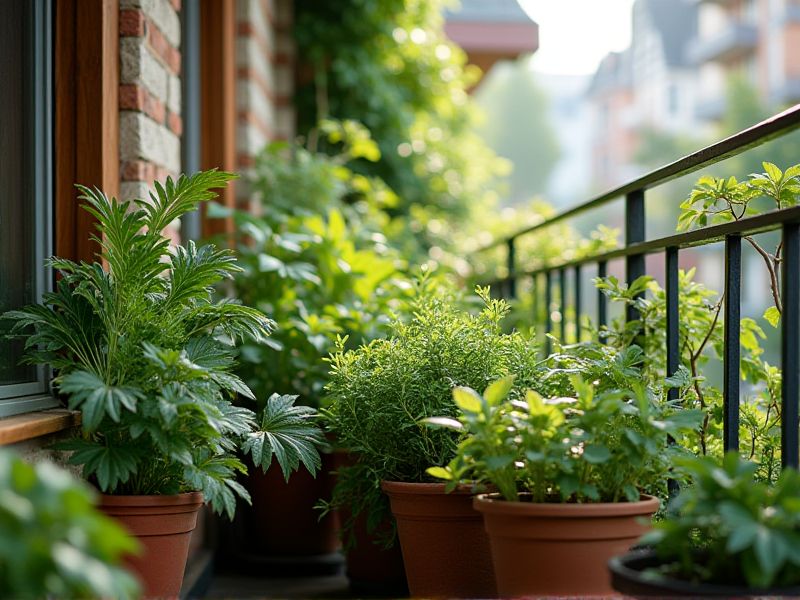
When selecting balcony plants that can withstand wind, consider hardy varieties such as ornamental grasses, lavender, and succulents. Ornamental grasses, like miscanthus, provide both resilience and visual appeal, moving gracefully with passing breezes. Lavender not only tolerates windy conditions but also adds fragrance and attracts pollinators to your outdoor space. For a low-maintenance option, succulents such as sedums offer drought resistance and can thrive even in exposed areas. Choosing pots with good drainage and securing tall plants can further enhance your balcony garden's stability against strong winds.
List of some Balcony plants that withstand wind
- Lavender (Lavandula)
- Rosemary (Rosmarinus officinalis)
- Juniper (Juniperus)
- Sedum (Sedum spp.)
- Bamboo (Bambusoideae)
- Blue Fescue (Festuca glauca)
- Boxwood (Buxus)
- Dwarf Alberta Spruce (Picea glauca 'Conica')
- Yucca (Yucca spp.)
- Ivy Geranium (Pelargonium peltatum)
Important things about Balcony plants that withstand wind
Choose Plants With Sturdy Stems
For balcony gardens, selecting plants with sturdy stems is essential to ensure resilience against strong winds. Consider incorporating species like ornamental grasses, such as Miscanthus or Panicum, as their deep roots and flexible stems can withstand gusts while adding texture to your space. Additionally, succulents like Agave or Yucca provide a robust option; their structural integrity allows them to thrive in exposed environments. You can enhance your balcony's stability by placing heavier planters at the base to anchor plants and help mitigate wind damage.
Select Low-Growing Varieties
When selecting low-growing balcony plants that can withstand wind, consider hardy varieties such as Sempervivum (hens and chicks), which thrive in rocky conditions and require minimal water. Other resilient options include sedums, known for their drought tolerance and fleshy foliage, making them ideal for narrow spaces exposed to breezy conditions. Low-growing ornamental grasses like Carex can add texture while also being strong enough to endure gusty winds. Your balcony will benefit from these robust plants, creating a vibrant and stable garden environment.
Opt For Drought-Tolerant Species
Drought-tolerant balcony plants, such as succulents and ornamental grasses, thrive in low-water conditions while withstanding strong winds. Varieties like Lavender, Sedum, and Festuca can serve as beautiful yet resilient options for maximizing your outdoor space. Planting them in well-draining soil and selecting windbreaks, like trellises or tall containers, can help maintain their health and integrity. You'll enjoy a vibrant, sustainable balcony garden that requires minimal maintenance and resource use.
Use Heavy Pots For Stability
Choosing heavy pots for your balcony plants provides essential stability against strong winds. Materials such as ceramic, concrete, or cast iron are excellent options, as they can help anchor your plants securely. Consider selecting larger pots, as their weight not only supports the plants but also reduces the risk of tipping over. When you use weighted containers, your balcony garden can thrive even in breezy conditions, ensuring your plants remain healthy and upright.
Consider Windbreaks Or Screens
Windbreaks are essential for protecting balcony plants from harsh winds, which can cause damage and stress to your greenery. Investing in sturdy yet attractive screens, such as bamboo or trellis designs, can create a natural barrier that shields your plants while enhancing your outdoor aesthetic. Positioning these screens strategically will reduce wind exposure and promote healthier growth by maintaining humidity levels. Selecting wind-resistant plants, such as ornamental grasses or hardy perennials, can further ensure your balcony remains vibrant, even in breezy conditions.
Ensure Proper Drainage In Pots
Proper drainage is crucial for balcony plants, especially those that need to withstand windy conditions. To prevent waterlogging, select pots with drainage holes and consider using a well-draining potting mix that promotes healthy root systems. Plants like ornamental grasses, sedums, and lavender not only tolerate wind but also thrive in challenging environments by anchoring themselves firmly in the soil. Regularly check the moisture levels in your pots, ensuring that your balcony garden remains vibrant and resilient despite the elements.
Group Plants Together For Protection
When selecting balcony plants that can withstand wind, consider hardy varieties such as ornamental grasses, succulents, and robust perennial flowers. Grouping these wind-resistant plants together creates a natural barrier, helping to shield delicate species from harsh gusts. For optimal growth, choose containers with good drainage and weight to prevent tipping; larger pots are generally more stable. Positioning taller plants at the back and shorter ones in the front enhances not only protection but also visual appeal.
Rotate Plants To Maximize Sun Exposure
Balcony plants that can withstand wind include resilient species such as lavender, ornamental grasses, and succulents, which thrive in exposed environments. To maximize sun exposure, rotate your plants periodically, ensuring that each side faces the sun, thus promoting even growth. This simple practice helps prevent plants from leaning towards the light and encourages a fuller, bushier appearance. Regular rotation, combined with a selection of wind-resistant plants, will create a vibrant and thriving balcony garden while optimizing sunlight absorption.
Use Soil With Good Weight Retention
Using soil with excellent weight retention is crucial for balcony plants, especially in windy conditions. Such soil typically consists of a mixture of organic materials like compost, peat moss, and vermiculite, which help anchor the plants and retain moisture. Selecting sturdy varieties, such as ornamental grasses or hardy succulents, can also enhance stability against strong gusts. You can ensure your plants thrive by providing adequate drainage while maintaining the right balance of soil weight, supporting healthy root systems during challenging weather.
Regularly Check For Damage And Pests
Regular inspections of your balcony plants are essential to ensure their health, as wind exposure can cause damage or attract pests. Look for signs of stress, such as broken branches or wilting leaves, which can indicate that your plants are struggling to thrive in windy conditions. Pest infestations may manifest as discolored leaves, webbing, or holes in the foliage, requiring immediate attention. Consider utilizing sturdy, wind-resistant plants like ornamental grasses or succulents that are well-suited for breezy environments, ensuring a flourishing balcony garden.
